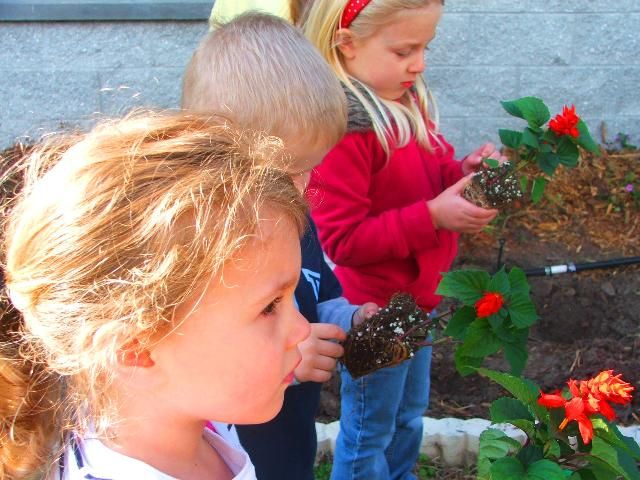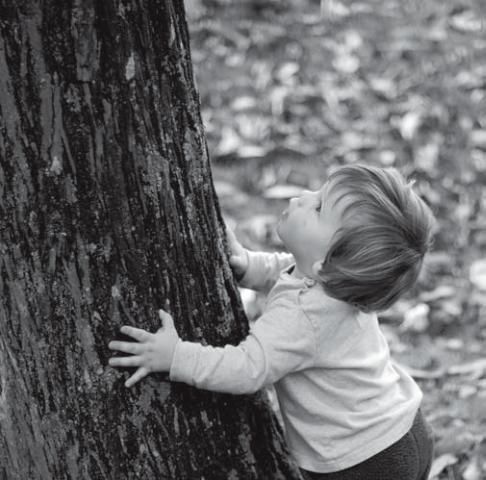Early childhood is a crucial period for the physical and cognitive development of children. People who work with young children—both formal and non-formal educators, preschool and nature center directors, school administrators and decision-makers, as well as other community leaders—might realize that the children in their care benefit from interactions with nature, but they might not have ready access to the literature that supports their observations. This publication reviews some of the literature and shows that young children need to go outside and be around nature regularly, describes some of the benefits children—and adults!—gain from learning and playing outdoors, and suggests several resources for parents, teachers, and caretakers who hope to increase these opportunities for their youngsters.
The Need for Early Childhood Environmental Education and Outdoor Recreation
It is critical for young children to interact with their natural environment both to develop a positive regard for the environment and to flourish as healthy individuals (Wilson 1996). In his book, Last Child in the Woods, Richard Louv summarized much of the research on children and nature and discussed the fading relationship that exists between children today and the environment (Louv 2005). The lack of interaction between children and their environment results in negative health effects on young children such as "childhood obesity, asthma, attention deficit disorder/hyperactivity disorder (ADHD), and vitamin D deficiency, all of which have increased in prevalence in the US over the past few decades," (McCurdy et al. 2010, p. 201).
Some argue that this might be the first generation of Americans to have a shorter lifespan than their parents (Olshansky et al. 2005). Incidents of childhood obesity, asthma, and attention-deficit disorders are rising (Perrin et al. 2007). Besides the risks to the physical well-being of children, a lack of outdoor play can limit creativity, impede cognitive development, and diminish social skills in young children (NLI 2012). A focus on more structured activities and stricter learning objectives in schools has reduced the time children once spent outside experiencing nature directly. Teachers and other concerned adults must actively strive to include both free play opportunities and facilitated outdoor learning experiences for youth. For a variety of benefits, children must spend more time outdoors interacting with the natural environment.

Credit: Project Learning Tree
Defining Early Childhood Environmental Education
Early childhood education typically focuses on children from birth through age eight (UNESCO 2015). Environmental education is one potential avenue to increase the amount of time children in this age group spend playing and learning in a natural environment. According to the North American Association for Environmental Education (NAAEE), environmental education (EE) "teaches children and adults how to learn about and investigate their environment, and to make intelligent, informed decisions about how they can take care of it"(NAAEE 2015). Early childhood environmental education (ECEE) is "a holistic concept that encompasses knowledge of the natural world as well as emotions, dispositions, and skills" (NAAEE 2010, p. 3). ECEE involves improving children's knowledge about the environment while developing a "positive and caring attitude toward the environment" (NAAEE 2010, p. 4).
There are several defining elements of EE suited for early childhood: nature play, physical activity, and learning about nature. Nature play is "unobstructed play in natural settings" and is child-directed, rather than educator-directed (Ernst 2012, p. 8). This play is largely exploration of natural elements that occurs in an unmaintained space—such as a local nature preserve rather than a backyard or structured playground—and furthers the physical, cognitive, and social development of young children (Ernst 2012). Outdoor physical activity includes running, jumping, climbing, and countless other types of movement essential for children's physical development. Finally, learning about nature is a key concept defining EE. Inclusion of the elements of learning and discovery distinguishes EE from recreation. At the early childhood level this learning typically includes becoming familiar with animals, plants, seasons, and weather (Torquati et al. 2013). Emphasizing positive and frequent interactions with nature, rather than environmental issues such as endangered species or climate change, fosters the innate curiosity young children have about nature without overwhelming them (NAAEE 2010).

Credit: Project Learning Tree

Credit: Project Learning Tree
The Importance of Starting Young
From a very early age, children are curious about the world around them. As they learn and grow, experiencing nature with all of their senses is a critical part of their development (NAAEE 2010). Exploration of the natural world allows young children to create a lasting attachment to the environment (NAAEE 2010). Even a slight age difference might affect the way that children react toward the environment. Studying the attitudes of fourth graders in comparison to sixth graders in Germany, it was discovered that "younger students obtained and maintained higher pro-environmental attitudes than their older counterparts," leading the authors to suggest that "the effect of environmental education...may be more effective with younger children" (Lieflander and Bogner 2014, p. 114). Creating a habit of physical activity at a young age can have lasting health benefits for children. For example, there is a link between the physical activity of twelve-year-old children and their bone mineral density when they reach their early twenties (Loprinzi et al. 2010). Chronic disease prevention can likewise be influenced by physical activity during childhood (Loprinzi et al. 2010).

Credit: Project Learning Tree
Summary
Contemporary children spend considerably less time outside than did children in previous generations. Decreases in interactions with nature can harm children's physical health and cognitive development and create a gap between children and their environment. Using ECEE to help children engage in outdoor experiences is a positive step concerned adults can take to reconnect young children with nature and allow them to explore their intrinsic interest in the natural world. ECEE programs that use age-appropriate behaviors and skills within environmental settings can foster children's curiosity, increase their knowledge, and develop their motor skills. Benefits from ECEE can have a lasting effect on children throughout their lives.
References
Burdette, H. L, and R. C. Whitaker. 2005. "Resurrecting free play in young children: Looking beyond fitness and fatness to attention, affiliation, and affect." Archives of Pediatric and Adolescent Medicine. 159, 46–50.
Ernst, J. 2012. "Early childhood nature play: A needs assessment of Minnesota licensed childcare providers." Journal of Interpretation of Research. 17(1) 7–24.
Lieflander, A. K., and F. X. Bogner. 2014. "The effects of children's age and sex on acquiring pro-environmental attitudes through environmental education." The Journal of Environmental Education. 45(2), 105–117.
Loprinzi, P., B. Cardinal, K. Loprinzi, and H. Lee. 2010. "Benefits and environmental determinants of physical activity in children and adolescents." Obesity Facts. 5, 567–610.
Louv, R. 2005. Last Child in the Woods, New York City, NY: Algonquin Books.
McCurdy, L., K. Winterbottom, S. Mehta, and J. Roberts. 2010. "Using nature and outdoor activity to improve children's health." Current problems in pediatric and adolescent health care. 40(5) 102–117.
NAAEE (North American Association for Environmental Education). 2015. What is Environmental Education? Retrieved from https://naaee.org/about/ee
NAAEE (North American Association for Environmental Education). 2010. Early Childhood Environmental Education Programs: Guidelines for Excellence. Washington, DC: North American Association for Environmental Education.
NLI (Natural Learning Initiative). January 2012. Benefits of connecting children with nature: Why naturalize outdoor learning environments. Retrieved from https://naturalstart.org/sites/default/files/benefits_of_connecting_children_with_nature_infosheet.pdf
Olshansky, S., D. Passaro, R. Hershow, J. Layden, B. Carnes, J. Brody, L. Hayflick, R. Butler, D. Allison, and D. Ludwig. 2005. "A potential decline in life expectancy in the United States in the 21st century." The New England Journal of Medicine. 352(11) 1138–1145.
Perrin, J., S. Blooms, and S. Gortmaker. 2007. "The increase of childhood chronic conditions in the United States." Journal of the American Medical Association. 297(24) 2755–2759.
Taylor, A. F., and F. E. Kuo. 2009. "Children with attention deficits concentrate better after walk in the park." Journal of Attention Disorders. 12(5) 402–409.
Torquati, J., K. Cutler, D. Gilkerson, and S. Sarver. 2013. "Early childhood educators' perceptions of nature, science, and environmental education." Early Education and Development. 24(5) 721–743.
UNESCO (United Nations Educational, Scientific and Cultural Organization). (2015). Early Childhood Care and Education. Retrieved from https://www.unesco.org/en/education/early-childhood
Wells, N., and G. W. Evans. 2003. Nearby nature: A buffer of life stress among rural children. Environment and Behavior 35(3) 311–330.
Wilson, R. A., (1996). Starting early: Environmental education during the early childhood years. ERIC Digest. p. 1–6. Retrieved from https://eric.ed.gov/?id=ED402147